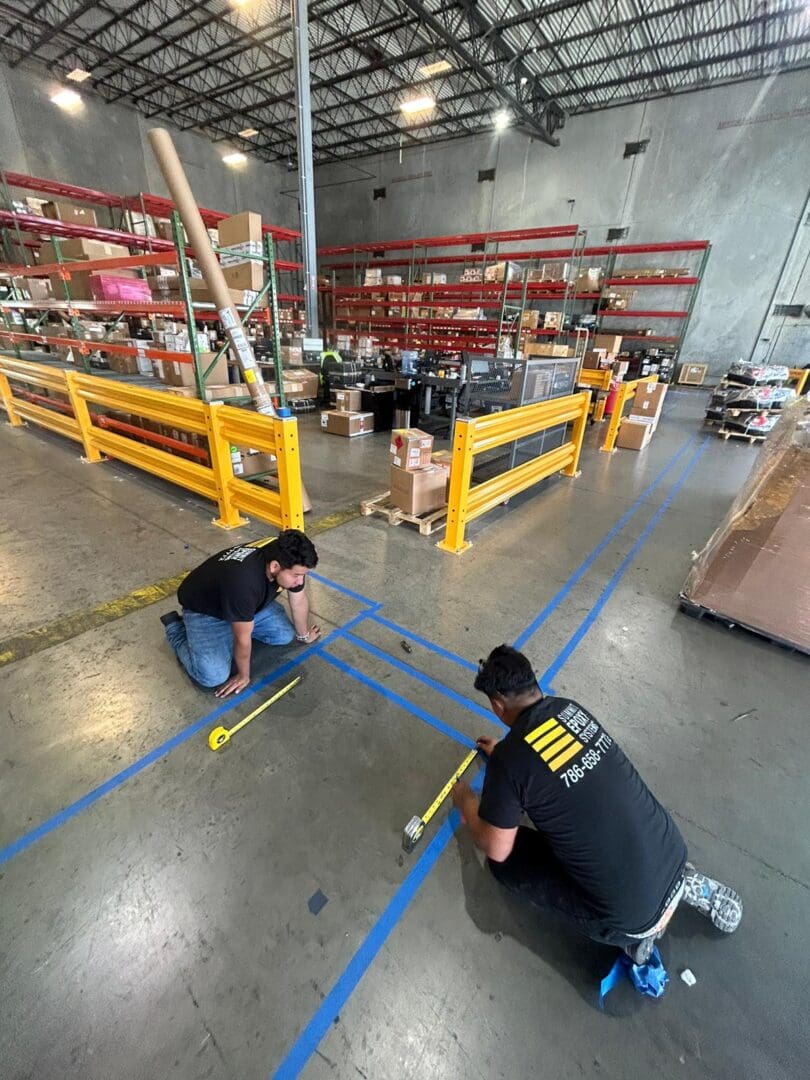Floor Striping & Epoxy Repair
Floor Striping:
- Definition: Floor striping involves the application of colored lines and markings on the floor surface to designate specific areas, pathways, or zones within a facility.
- Types of Floor Striping:
- Aisle Marking: Indicates designated pathways for pedestrian and vehicle traffic, helping to maintain organized movement within the facility.
- Safety Marking: Includes markings for hazardous areas, emergency exits, fire extinguishers, and other safety equipment, enhancing workplace safety and compliance.
- Storage Area Marking: Designates locations for storage racks, shelves, and bins, optimizing space utilization and facilitating efficient inventory management.
- Workstation Marking: Marks boundaries for individual workstations, machinery, and equipment, ensuring clear demarcation and preventing overcrowding or obstruction.
- Materials: Floor striping is typically done using durable floor marking tapes, paints, or epoxy coatings designed to withstand heavy traffic, abrasion, and chemical exposure.
- Benefits:
- Safety: Clearly defined pathways and hazard zones improve safety by reducing the risk of accidents, collisions, and slips.
- Organization: Facilitates efficient workflow and inventory management by providing visual cues for navigation and storage.
- Compliance: Helps facilities comply with regulatory requirements and safety standards by clearly marking emergency exits, fire lanes, and other critical areas.


Epoxy Floor Repair:
- Definition: Epoxy floor repair involves the application of epoxy-based coatings or patches to restore damaged or deteriorated concrete floor surfaces.
- Types of Damage: Epoxy floor repair can address various types of damage, including cracks, spalling, delamination, and surface erosion caused by heavy traffic, impact, or chemical exposure.
- Repair Process:
- Surface Preparation: The damaged area is cleaned, degreased, and prepared to ensure proper adhesion of the epoxy repair materials.
- Crack Filling: Epoxy or polyurethane-based fillers are used to fill cracks and voids in the concrete surface, preventing further deterioration and improving structural integrity.
- Patch Application: Epoxy-based patching compounds or mortars are applied to repair surface defects such as spalls, pits, and gouges, restoring the smoothness and evenness of the floor surface.
- Topcoat Application: A protective epoxy topcoat is applied to seal and protect the repaired area, enhancing durability and resistance to wear, abrasion, and chemical damage.
- Benefits:
- Durability: Epoxy floor repairs provide long-lasting solutions that withstand heavy traffic, impact, and chemical exposure, extending the lifespan of the floor surface.
- Safety: Smoothing out uneven surfaces and repairing cracks and defects reduces trip hazards and improves overall workplace safety.
- Aesthetics: Epoxy coatings and patches can be customized with various colors and finishes to enhance the appearance of the floor surface and complement the facility’s décor.
- Cost-Effectiveness: Epoxy floor repair is often more cost-effective than complete floor replacement, minimizing downtime and disruption to operations.
In summary, floor striping and epoxy floor repair are essential maintenance practices that contribute to safety, organization, and durability in industrial and commercial facilities. By clearly marking pathways, hazards, and storage areas, and by repairing damaged concrete surfaces, these maintenance activities help create a safer, more efficient, and visually appealing work environment.
